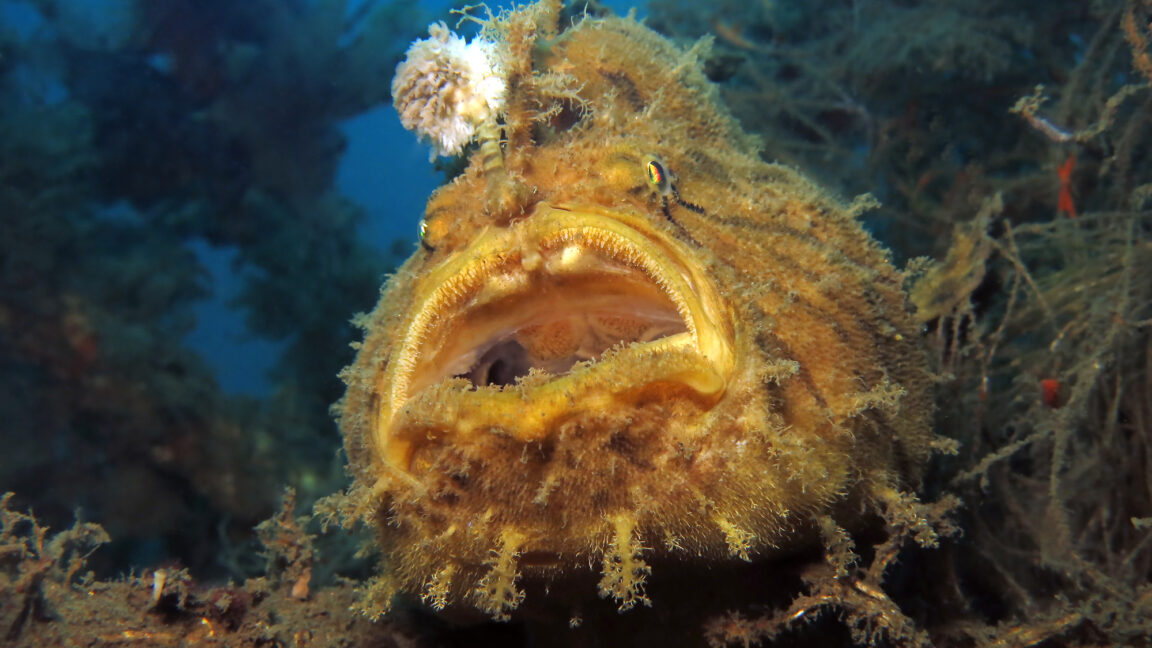ARSTECHNICA.COM
Frogfish reveals how it evolved the fishing rod on its head
Gone fishin' Frogfish reveals how it evolved the fishing rod on its head Specialized neurons have evolved to make the "bait" wiggle like prey. Elizabeth Rayne Dec 30, 2024 1:27 pm | 0 A hairy frogfish seen off the coast of Indonesia. Credit: Divelvanov via Getty A hairy frogfish seen off the coast of Indonesia. Credit: Divelvanov via Getty Story textSizeSmallStandardLargeWidth *StandardWideLinksStandardOrange* Subscribers only Learn moreBehold the frogfish. This bizarre creature really is a fish, despite its bullfrog face, pectoral fins that look like webbed feet, and a froglike mouth that snaps up unsuspecting prey.But the way it lures its prey is even weirder. Frogfish belong to the anglerfish family known as Antennariidae. Like their anglerfish cousins who lurk in the oceans depths, these ambush predators attract their next meal via an appendage on their heads that they use like a fishing lure. This appendage is known as the illicium and thought to have once been a dorsal fin. It has a specialized skin flap, the esca at the end. It tantalizes small fish and crustaceans into thinking its a worm until they come too close.How frogfish controlled the illicium was previously unknown. Led by biologist Naoyuki Yamamoto of Nagoya University, a team of researchers have now discovered that a specialized population of motor neurons have evolved to allow it to shake the illicium around like a wriggling worm. Yamamoto thinks they were originally dorsal fin motor neurons that became more specialized.Thats some nerveTo find out how the illicium was innervated, or supplied with nerves, the researchers injected striated frogfish (also called the hairy frogfish for the hairlike skin protrusions all over its body) with neural tracers that would color specific parts of its nervous system so they became visible. Frogfish motor neurons were then compared to those of the related white-spotted pygmy filefish.Yamamoto and his team found that the illicial muscles of the frogfish are innervated by motor neurons in branches of the occipital nervewhich is responsible for sensation in the head and neck. These cells reside in whats called the dorsolateral zone of the ventral hornthe dorsolateral zone of the spine is in the upper back of the fish, while the ventral horn is the underside of the spine. It is these fishing motor neurons that allow them to move the illicium when lying in wait for prey among rocks or on the seafloor.In most bony fish, or teleosts, motor neurons for fins are found on the sides (ventrolateral zone) of the underside (ventral horn) of the spinal cord. The motor neurons controlling the illicium of frogfish are in their own cluster and located in the dorsolateral zone. In fish, this is unusual.The peculiar location of fishing motor neurons, with little doubt, is linked with the specialization of the illicium serving fishing behavior, the team said in a study recently published in the Journal of Comparative Neurology.Fishing for answersSo what does this have to do with evolution? The white-spotted pygmy filefish might look nothing like a frogfish and has no built-in fishing lure, but it is still a related species and can possibly tell us something.While the first dorsal fin of the filefish doesnt really moveit is thought that its main purpose is to scare off predators by looking menacingthere are still motor neurons that control it. Motor neurons for the first dorsal fin of filefish were found in the same location as motor neurons for the second, third and fourth dorsal fins in frogfish. In frogfish, these fins also do not move much while swimming, but can appear threatening to a predator.If the same types of motor neurons control non-moving fins in both species, the frogfish has something extra when it comes to the function and location of motor neurons controlling the illicium.Yamamoto thinks the unique group of fishing motor neurons found in frogfish suggests that, as a result of evolution, "the motor neurons for the illicium [became] segregated from other motor neurons to end up in their own distinct cluster away from motor neurons controlling other fins, as he said in the study.What exactly caused the functional and locational shift of motor neurons that give the frogfishs illicium its function is still a mystery. How the brain influences their fishing behavior is another area that needs to be investigated.While Yamamoto and his team speculate that specific regions of the brain send messages to the fishing motor neurons, they do not yet know which regions are involved, and say that more studies need to be carried out on other species of fish and the groups of motor neurons that power each of their dorsal fins.In the meantime, the frogfish will continue being its freaky self.Journal of Comparative Neurology, 2024. DOI: 10.1002/cne.25674Elizabeth Rayne Elizabeth Rayne is a creature who writes. Her work has appeared on SYFY WIRE, Space.com, Live Science, Grunge, Den of Geek, and Forbidden Futures. She lurks right outside New York City with her parrot, Lestat. When not writing, she is either shapeshifting, drawing, or cosplaying as a character nobody has ever heard of. Follow her on Threads and Instagram @quothravenrayne. 0 Comments
